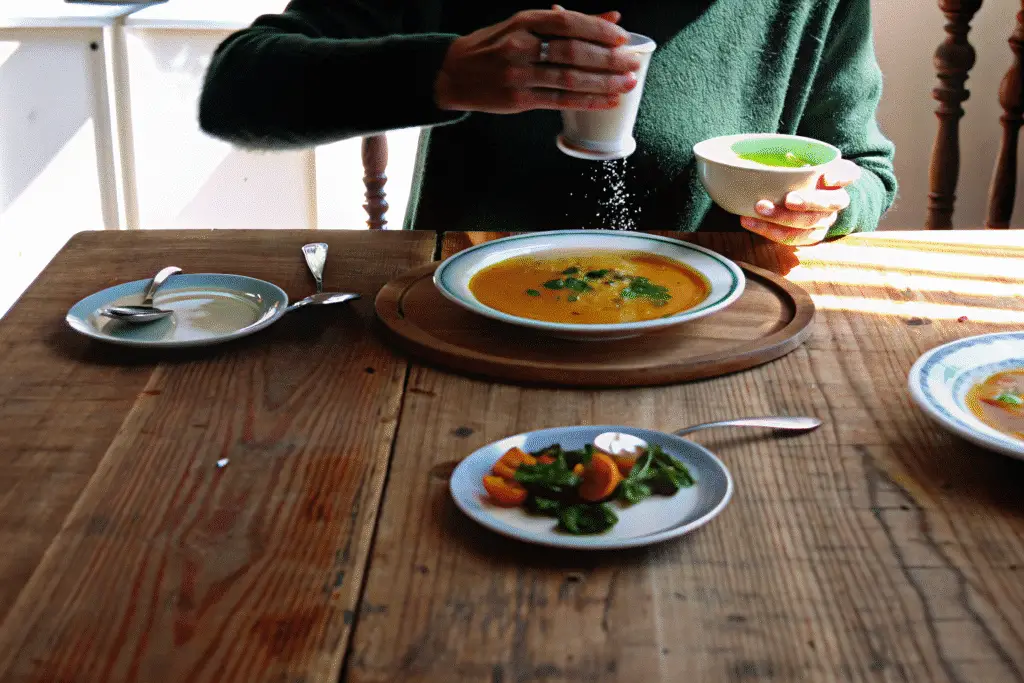Fibermaxxing is the latest TikTok trend that’s moved from niche wellness circles into mainstream nutrition conversations. At its core, it simply means eating more fiber—loading your plate with fruits, beans, oats, veggies, and seeds to support digestion, fullness, and overall health. Dietitians point out that it’s less about hype and more about returning to a balanced, plant-forward lifestyle that supports gut health and long-term well-being.

When I first heard the term “fibermaxxing,” I couldn’t help but smile. Growing up, my grandma never used trendy words like that—she just ladled out bowls of her hearty lentil soup, rich in beans and vegetables from her garden. Back then, we didn’t think of it as “maxxing.” We just thought of it as food that kept you feeling full and strong. Today, TikTok has given it a name, but the roots of the practice are timeless.
And here’s the truth: most of us fall short. Studies show nearly 90% of Americans don’t eat enough fiber daily. That’s where fibermaxxing comes in—not as a fad, but as a reminder to make fiber the star of your meals.
Table of Contents
What is fibermaxxing?
Fibermaxxing is the practice of intentionally increasing fiber intake to meet or exceed daily recommended amounts. The focus is on centering meals around fiber-rich foods—whole grains, legumes, nuts, seeds, fruits, and vegetables—rather than restricting or cutting out other foods.
Unlike strict diets, there’s no one-size-fits-all rulebook. For some, it looks like sprinkling chia seeds into overnight oats. For others, it’s swapping white rice for brown or tossing an extra handful of beans into chili. The idea is to maximize daily fiber in simple, consistent ways, letting your gut (and taste buds) thank you in return.
Why are people fibermaxxing?
Yes—fibermaxxing is trending because TikTok has turned a simple nutrition principle into a viral movement. Videos with the hashtag “fibermaxxing” have gained millions of views, with creators claiming it helps with bloating, energy, and even weight management. The idea is appealing: a low-cost, natural way to support gut health without supplements or complicated meal plans.
From a health perspective, it makes sense. Fiber plays a key role in digestion, blood sugar regulation, satiety, and gut microbiome diversity. And because most of us are falling short on the recommended 25–35 grams per day, the idea of “maxxing out” fiber resonates with anyone who wants a quick fix that feels wholesome.

But here’s the nuance: fibermaxxing isn’t really new. It’s a rebranding of what nutritionists have always encouraged—more whole plants, fewer ultra-processed shortcuts. What TikTok does brilliantly is give it a catchy name and an online community, making it feel fun and accessible rather than clinical or intimidating.
I felt this shift myself one Saturday at the local farmer’s market. I saw stalls piled high with kale, lentils, and raspberries, and overheard a young couple debating which beans were “best for fibermaxxing.” It struck me—this wasn’t diet culture or calorie counting. This was a playful, positive approach to nourishing the gut. And maybe that’s why it resonates so widely: it’s not about restriction, it’s about adding abundance.
What is the optimal amount of fiber to have per day?
The recommended minimum daily fiber intake depends on age and sex. Here’s a clear breakdown:
Adult fiber intake
| Adults (19–30 years) | Adults (31–50 years) | Adults (51+ years) | |
|---|---|---|---|
| Male | 34 g | 31 g | 28 g |
| Female | 28 g | 25 g | 22 g |
Child and adolescent fiber intake
| Daily fiber intake | |
|---|---|
| Children 2–3 years | 14 g |
| Children 4–8 years | 17 g (female), 20 g (male) |
| Children 9–13 years | 22 g (female), 25 g (male) |
| Adolescents 14–18 years | 25 g (female), 31 g (male) |
These numbers explain why fibermaxxing matters—most people fall short of even these minimums.
But keep in mind: taking in much more fiber than your recommended daily intake can backfire. Symptoms like bloating, cramps, or constipation often pop up when you overshoot, especially without enough water. The sweet spot is to aim for your target, increase gradually, and listen to your body.
How do I start fibermaxxing?
Getting started with fibermaxxing doesn’t mean overhauling your entire diet overnight. In fact, dietitians warn that going too fast can backfire with bloating or discomfort. Instead, think of it as a gentle layering of habits that build over time.
Here’s a beginner-friendly roadmap:
| Step | What to Do | Example | Why It Works |
|---|---|---|---|
| 1 | Add one extra serving of fiber-rich food daily | Swap white rice for brown rice | Increases insoluble fiber for digestion |
| 2 | Mix soluble + insoluble fiber | Oats with chia seeds and raspberries | Balances blood sugar + supports microbiome |
| 3 | Hydrate well | Drink 6–8 glasses of water | Prevents constipation and discomfort |
| 4 | Spread fiber across meals | Add beans to lunch, fruit for snack | Keeps energy steady, avoids overload |
| 5 | Increase gradually | Aim for +3–5g per week | Allows gut bacteria to adapt smoothly |
The key? Start small, stay consistent, and listen to your body.
When I began fibermaxxing, I thought I had to hit 30 grams overnight. My gut quickly reminded me that fiber is best built slowly. Once I shifted to adding one serving at a time—chia in oats, broccoli in stir fry—I felt lighter, more energized, and surprisingly more satisfied after meals.
Fibermaxxing isn’t about complicated math; it’s about creating simple food rituals that make fiber feel abundant and joyful.
What kinds of fiber can you add to your diet?
Fiber isn’t just one nutrient—it comes in two main forms, and both are important when you’re fibermaxxing.
Soluble fiber dissolves in water and forms a gel-like substance in your gut. It helps slow digestion, steady blood sugar, and lower cholesterol. You’ll find it in foods like:
- Oats
- Chia and flax seeds
- Apples
- Beans
- Avocados

Insoluble fiber doesn’t dissolve in water. Instead, it acts like a broom, sweeping through your digestive tract to keep bowel movements regular and comfortable. You’ll find it in:
- Whole grains (brown rice, quinoa, barley)
- Nuts
- Leafy greens
- Fruit and veggie skins
💡 Pro tip: Most whole foods contain a mix of both fibers. The magic isn’t in picking one over the other—it’s in creating variety on your plate.
When I was little, my grandma used to say: “Eat the rainbow.” Her table always had something red (tomatoes), green (spinach), yellow (corn), and purple (cabbage). Back then, I thought it was just about color, but really, she was teaching me fiber diversity. That same idea powers fibermaxxing today.
Need inspiration? Try these simple combos that mix soluble and insoluble fiber:
- Overnight oats with raspberries, ground flax, and almonds
- Lentil soup with kale and whole-grain toast
- A veggie bowl with sweet potatoes, cabbage slaw, and pumpkin seeds
Each bite becomes a mini “fiber upgrade.”
How does fibermaxxing benefit you?
When done gradually and consistently, fibermaxxing can transform how you feel day to day. Dietitians point to four key benefits:
Regulates blood sugar
Soluble fiber slows digestion, meaning sugars are absorbed more steadily. No more rollercoaster crashes after breakfast—just even, stable energy.
Protects heart health
Fiber binds to cholesterol and fats, helping to lower LDL (“bad”) cholesterol. Over time, this reduces your risk of heart disease and supports circulation.
Boosts digestion
Fiber adds bulk to stool, prevents constipation, and feeds beneficial gut bacteria. Think of it as fertilizer for your microbiome garden.
Promotes satiety
High-fiber meals keep you fuller for longer, making it easier to avoid overeating or mindless snacking.
When I tried fibermaxxing for a week, the biggest surprise wasn’t just better digestion—it was how satisfied I felt. My morning oats with chia and raspberries carried me through until lunch, something coffee alone never did. Instead of chasing energy all day, I found myself calmer, steady, and fueled.
The beauty of fibermaxxing is that it doesn’t rely on restriction—it’s about adding abundance. More colors, more textures, more flavors. And with every bowl of soup or crunchy apple, you’re investing in long-term wellness.
How much fiber is too much?
Yes—too much fiber can be a problem. While fibermaxxing is generally safe, jumping from 10 grams a day to 40 grams overnight can cause:
- Gas and bloating
- Abdominal cramps
- Constipation (if water intake is too low)
- Loose stools or diarrhea (if insoluble fiber is too high)
The sweet spot? Most adults feel best at 25–35 grams daily, though needs vary. The key is to increase slowly, about 3–5 grams per week, while drinking plenty of water.
I learned this lesson the hard way with chia pudding. Excited by the trend, I made a giant jar and polished it off in one sitting. Instead of feeling energized, I felt like a balloon. My gut reminded me that fiber is powerful medicine—and like medicine, it works best in the right dose.
So here’s the golden rule: fibermaxxing should feel nourishing, not punishing. If your gut feels upset, scale back, add hydration, and let your body adjust.
Which foods are best for fibermaxxing?
The best foods for fibermaxxing are the ones nature has already packed with fiber—fruits, vegetables, legumes, seeds, nuts, and whole grains. Here’s a handy guide:
Top High-Fiber Foods
- Legumes: lentils, chickpeas, black beans
- Seeds: chia, flax, sunflower
- Fruits: raspberries, pears, apples (with skin)
- Vegetables: broccoli, kale, carrots
- Whole Grains: oats, quinoa, barley, brown rice
- Nuts: almonds, pistachios, peanuts
Easy Fiber-Boosting Swaps
- White rice → brown rice or quinoa
- Potato chips → air-popped popcorn
- White bread → whole-grain bread
- Sugary snacks → fruit + nut mix
When I think of fiber-rich foods, I remember my grandma’s pantry: glass jars filled with lentils and beans stacked neatly on a wooden shelf. For her, these weren’t “superfoods.” They were just everyday staples, simmered slowly into soups and stews that filled the house with comforting aromas.
That’s the heart of fibermaxxing—it’s not about exotic powders or pricey supplements. It’s about reaching for simple, wholesome foods that have always been part of traditional kitchens.
Extra tips for fibermaxxing
Focus on Fiber-Rich Whole Foods
The foundation of fibermaxxing is simple: eat more plants in their natural state. Think beans, oats, veggies, and fruit with the skin on. Whole foods give you not just fiber, but also vitamins, minerals, and antioxidants.
Supplements Can Help
If you’re struggling to meet daily goals, fiber powders or psyllium husk can bridge the gap. But remember—supplements should support, not replace, whole foods. Nothing beats the flavor or nutrients of real food.
Follow Your Fiber Intake Over Time
Track your fiber for a week using an app or food journal. You might be surprised where you’re falling short—or where you’re getting more than you realized. Awareness is the first step to balance.
Increase Gradually
Your gut thrives on consistency, not shock. Add fiber in small steps: a spoonful of chia in your smoothie today, beans in your salad tomorrow. Over time, those little changes add up to a fiber-rich lifestyle without discomfort.
Fibermaxxing is less about chasing perfection and more about building gentle, sustainable rituals. For me, it started with overnight oats topped with berries, then evolved into lentil soups and veggie bowls that left me full and energized.
The beauty is, you don’t need a total kitchen overhaul—just a few thoughtful choices, repeated daily.
Conclusion
Fibermaxxing may sound like a flashy new TikTok trend, but at its heart, it’s simply about returning to the foods that have always nourished us—beans simmered in soups, oats stirred into porridge, and fresh fruits enjoyed with their skins on. What social media has given a catchy name to, our grandmothers and ancestors quietly practiced for generations.
When I began experimenting with fibermaxxing, I realized it wasn’t about chasing numbers or hitting a perfect target. It was about adding abundance to my meals—more color, more crunch, more plants. And with every bowl of lentil soup or handful of raspberries, I felt lighter, steadier, and more connected to the kind of wholesome eating I grew up with.
The beauty of this trend is that it isn’t restrictive. It doesn’t tell you what not to eat. Instead, it invites you to fill your plate with more of what makes you feel good inside and out. And that’s what Sofie Recipes is all about: soulful, globally inspired cooking that’s simple, nourishing, and accessible for every home cook.
Now it’s your turn—try a little fibermaxxing this week. Maybe it’s a sprinkle of chia seeds on your yogurt or an extra scoop of beans in your chili. However you make it your own, I’d love to hear your story.
Explore beautifully curated weight loss pink salt recipe ideas on Sofie Recipes on Pinterest and find your next favorite healthy habit!
FAQs
What happened when I ate 25 grams of fiber every day?
Yes—most people notice better digestion, less snacking, and steadier energy when they consistently eat 25 grams of fiber daily. At first, you may feel a little bloated, but your gut usually adjusts within a week or two.
What food is the highest in fiber?
Legumes top the chart—lentils, chickpeas, and black beans pack 15+ grams per cup. Seeds like chia and flax are also fiber superstars. Adding these to soups, salads, or overnight oats makes fibermaxxing effortless.
What are the symptoms of too much fiber in the body?
Too much fiber can cause gas, bloating, constipation, or even diarrhea—especially if you don’t drink enough water. The solution: increase gradually and hydrate well.
What is the best fiber for weight loss?
Soluble fiber is the most effective for weight loss because it slows digestion and helps you feel full. Oats, beans, apples, and chia are excellent choices.
How to get 50g of fiber a day?
It depends—most people don’t need quite that much, but if you do aim for 50g, spread it across meals. Think oatmeal with chia for breakfast, bean salad for lunch, lentil soup for dinner, and fruit + nuts as snacks.
What drinks are high in fiber?
Smoothies with leafy greens, chia seeds, flax, or berries can deliver 5–10 grams of fiber per serving. Unlike juices, smoothies keep the fiber intact.
What are high fiber foods for kids?
Yes—kid-friendly options include apples, bananas, pears, whole wheat toast, and nut butter. Keeping it simple and fun (like muffins or smoothies) makes fibermaxxing child-friendly.
Does banana have fiber?
Yes—a medium banana has about 3 grams of fiber, mostly soluble. Pair it with peanut butter for an easy snack that’s both filling and gut-friendly.
What are fiber-rich foods for bowel movements?
Prunes, beans, pears, and leafy greens are excellent. They contain a mix of soluble and insoluble fiber, which keeps digestion smooth and regular.
Is peanut butter high in fiber?
Yes, but moderately—about 2–3 grams per serving. Pairing it with fruit or whole-grain bread makes it a tasty and effective fibermaxxing choice.
